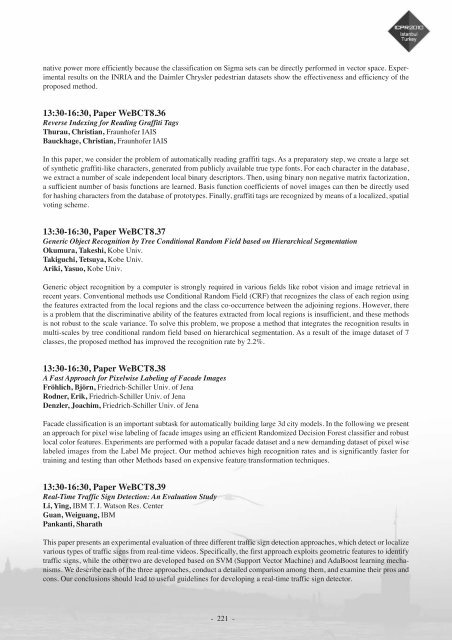Abstract book (pdf) - ICPR 2010
Abstract book (pdf) - ICPR 2010
Abstract book (pdf) - ICPR 2010
- TAGS
- abstract
- icpr
- icpr2010.org
Create successful ePaper yourself
Turn your PDF publications into a flip-book with our unique Google optimized e-Paper software.
native power more efficiently because the classification on Sigma sets can be directly performed in vector space. Experimental<br />
results on the INRIA and the Daimler Chrysler pedestrian datasets show the effectiveness and efficiency of the<br />
proposed method.<br />
13:30-16:30, Paper WeBCT8.36<br />
Reverse Indexing for Reading Graffiti Tags<br />
Thurau, Christian, Fraunhofer IAIS<br />
Bauckhage, Christian, Fraunhofer IAIS<br />
In this paper, we consider the problem of automatically reading graffiti tags. As a preparatory step, we create a large set<br />
of synthetic graffiti-like characters, generated from publicly available true type fonts. For each character in the database,<br />
we extract a number of scale independent local binary descriptors. Then, using binary non negative matrix factorization,<br />
a sufficient number of basis functions are learned. Basis function coefficients of novel images can then be directly used<br />
for hashing characters from the database of prototypes. Finally, graffiti tags are recognized by means of a localized, spatial<br />
voting scheme.<br />
13:30-16:30, Paper WeBCT8.37<br />
Generic Object Recognition by Tree Conditional Random Field based on Hierarchical Segmentation<br />
Okumura, Takeshi, Kobe Univ.<br />
Takiguchi, Tetsuya, Kobe Univ.<br />
Ariki, Yasuo, Kobe Univ.<br />
Generic object recognition by a computer is strongly required in various fields like robot vision and image retrieval in<br />
recent years. Conventional methods use Conditional Random Field (CRF) that recognizes the class of each region using<br />
the features extracted from the local regions and the class co-occurrence between the adjoining regions. However, there<br />
is a problem that the discriminative ability of the features extracted from local regions is insufficient, and these methods<br />
is not robust to the scale variance. To solve this problem, we propose a method that integrates the recognition results in<br />
multi-scales by tree conditional random field based on hierarchical segmentation. As a result of the image dataset of 7<br />
classes, the proposed method has improved the recognition rate by 2.2%.<br />
13:30-16:30, Paper WeBCT8.38<br />
A Fast Approach for Pixelwise Labeling of Facade Images<br />
Fröhlich, Björn, Friedrich-Schiller Univ. of Jena<br />
Rodner, Erik, Friedrich-Schiller Univ. of Jena<br />
Denzler, Joachim, Friedrich-Schiller Univ. of Jena<br />
Facade classification is an important subtask for automatically building large 3d city models. In the following we present<br />
an approach for pixel wise labeling of facade images using an efficient Randomized Decision Forest classifier and robust<br />
local color features. Experiments are performed with a popular facade dataset and a new demanding dataset of pixel wise<br />
labeled images from the Label Me project. Our method achieves high recognition rates and is significantly faster for<br />
training and testing than other Methods based on expensive feature transformation techniques.<br />
13:30-16:30, Paper WeBCT8.39<br />
Real-Time Traffic Sign Detection: An Evaluation Study<br />
Li, Ying, IBM T. J. Watson Res. Center<br />
Guan, Weiguang, IBM<br />
Pankanti, Sharath<br />
This paper presents an experimental evaluation of three different traffic sign detection approaches, which detect or localize<br />
various types of traffic signs from real-time videos. Specifically, the first approach exploits geometric features to identify<br />
traffic signs, while the other two are developed based on SVM (Support Vector Machine) and AdaBoost learning mechanisms.<br />
We describe each of the three approaches, conduct a detailed comparison among them, and examine their pros and<br />
cons. Our conclusions should lead to useful guidelines for developing a real-time traffic sign detector.<br />
- 221 -



